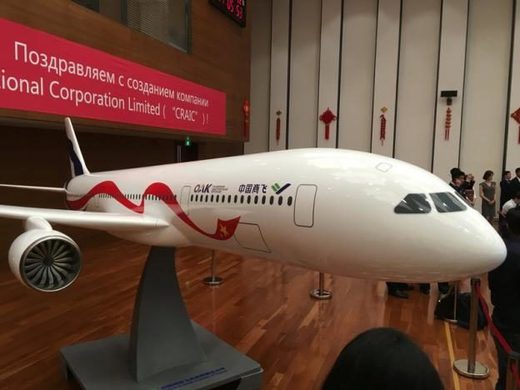Wednesday, May 24th., 2017
China and Russia take on aviation giants Boeing and Airbus in launch of joint venture to build wide-body commercial jet

A model of a jet is pictured at the launching ceremony of China-Russia Commercial Aircraft International Corporation Limited (CRAIC), a joint venture between Commercial Aircraft Corporation of China (COMAC) and Russia's United Aircraft Corp (UAC), in Shanghai, China May 22, 2017.
State plane makers Commercial Aircraft Corp of China Ltd (COMAC) [CMAFC.UL] and Russia's United Aircraft Corp (UAC) said at a ceremony in Shanghai the venture would aim to build a "competitive long range wide-body commercial aircraft".
The announcement comes just weeks after COMAC successfully completed the maiden flight of its C919, China's first home-grown narrow-body passenger jet.
COMAC President Jin Zhuanglong said the two firms had decided to hold the establishment ceremony after the C919's flight.
"This program is aimed at fulfilling future market demand," he told reporters. "Our two countries, our two firms ... have created this joint venture to undertake responsibilities such as organization, research, management and implementation."
The program will have a research center in Moscow and assembly line in Shanghai, he said, adding division of labor was still being discussed.
Guo Bozhi, general manager of COMAC's wide-body department, said the venture would ask suppliers to bid for the contract to build the engine by year-end.
Maiden Flight
COMAC and UAC first announced the program in 2014. In November, they said they had set up a joint venture in Shanghai and unveiled a mock-up of the basic version of the jet that would have a range of up to 12,000 kilometers (7,500 miles) and seat 280 passengers.
UAC President Yuri Slyusar said the firms looked to complete the maiden flight and first delivery during 2025-2028, and aimed to take 10 percent of a market dominated by the Boeing 787 and Airbus A350.
Previously, they targeted a maiden flight in 2022 and delivery in or after 2025.
UAC is also developing a version of Russian wide-body jet Ilyushin IL-96. Slyusar said the two programmes had different requirements, and that UAC would use experience with the IL-96 to aid development of the Chinese-Russian jet.
UAC and COMAC hold equal shares in their venture, whose jet they said would be 10-15 percent cheaper to run than planes from Boeing and Airbus.
Last July, Boeing forecast airlines worldwide would need 9,100 wide-body planes over 20 years through 2035, with a wave of replacement demand around 2021-2028.
Over the past decade, China has plowed billions of dollars into domestic jet development to raise its profile in global aviation and boost high-tech manufacturing.




